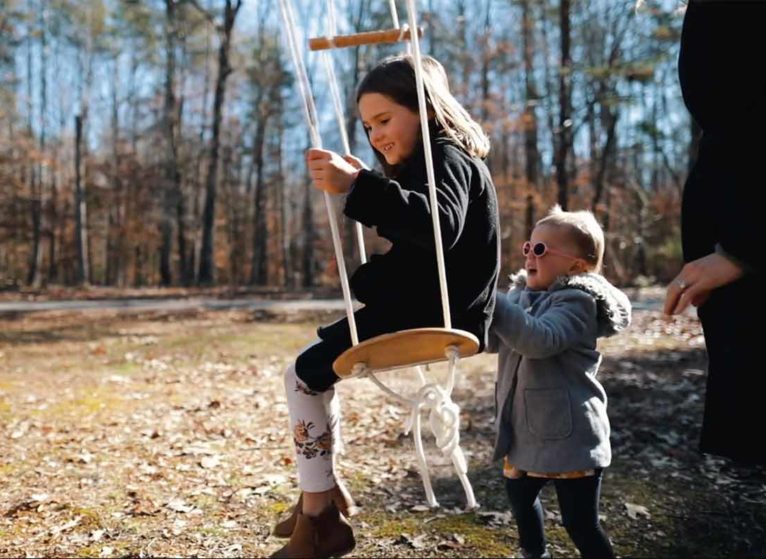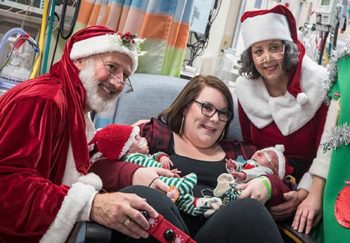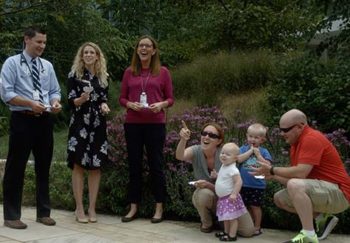Congenital heart disease (CHD) is the most common type of birth defect, according to the Centers for Disease Control. Still, Jen and Shawn Stiffler had no reason to think that it would affect two of their kids.
Their first child, Wade, had no heart issues. But when Scout was a newborn, Jen took her to the doctor for a suspected ear infection.
Scout’s Congenital Heart Disease Diagnosis
Scout ended up having something much more serious than an ear infection. Her pediatrician detected a problem with her heartbeat. Doctors diagnosed her with a congenital heart defect called permanent junctional reentrant tachycardia (PJRT).
Essentially, that meant she had a “problem with the electricity of her heart, causing her to have bad heart rhythm,” says pediatric cardiologist Peter Dean, MD.
Scout was admitted to a hospital near her home in Hanover County. After 2 weeks, the hospital transferred her to UVA.
Jen Stiffler: So my husband Shawn and I, we have three kids-- Wade, Scout, and Penn. Both of our little girls were born with undiagnosed congenital heart defects.
Shawn Stiffler: I just happened to be at work one day, and she had mentioned that Scout had an ear infection and she was taking her into the doctor's. Then I got a text message saying, you better get over here. The surgery that she was going to require had only been done at that point, I believe, one or two times on a child as small as her in the country.
Peter Dean, MD: Scout didn't have a problem with kind of the plumbing of her heart. She had a problem with the electricity of her heart causing her to have a bad heart rhythm. So she was cared for by our neonatology team along with our heart rhythm specialist, Dr. George McDaniel. We were able to give her various medicines to stabilize her blood pressures and her heart rates and get it under control.
Jen: The night before the surgery, at 11:00 PM, she flipped into normal rhythm. And she's been cleared now at age six of any heart condition, and I'm just forever grateful. [MUSIC PLAYING] So we had our third, and her name is Penn. And she was our second to be born with an undiagnosed congenital heart defect, and hers was much more serious than Scout's. G. Thomas Albrecht, MD: The right side of her heart did not develop prenatally, and there was some real discussion as to what kind of outcome she would have.
Jen: They said, what hospital would you like to go to? And my husband and I both said, immediately, UVA.
Shawn: We pulled into the emergency room, got into the ICU. I kind of felt like, phew, everything's going to be OK.
Jen: There was one doctor, Dr. Peter Dean, who thought that there was a possibility that, if we did this cath procedure, that they could balloon open her right ventricle. So if we could get blood flow into the heart, there was a chance that we could give her enough time to have her heart grow.
Dr. Dean: Dr. Hainstock is our interventional cardiologist who was able to perform a cath a few days later. Fortunately, it all went very well, and we were pleased with the outcomes. And fortunately, her right ventricle has kind of continued to grow.
Jen: It worked. It worked beautifully. We were told, on year two, that she does not need her other two open-heart surgeries. Her heart has grown to normal size because of that cath procedure. It has been the most incredible experience. They took something that is so scary-- it's your worst nightmare as a parent-- and they made us feel comfortable and capable.
The Stifflers knew that was the right decision. U.S. News & World Report has ranked UVA’s pediatric cardiology and heart surgery services in its “Best Children’s Hospital” guide since 2016. UVA also has the largest fetal heart program in Virginia.
Scout’s doctors decided to do an ablation procedure. This would surgically destroy small areas of heart tissue that cause irregular heartbeats. At 3 weeks old, Scout would have been the youngest child in the U.S. to ever have this procedure.
But first, doctors tried medication. And the night before the ablation procedure, Scout’s heart began beating normally. She continued to take medication until she was two. More recently, her doctors told the Stifflers that Scout, now 7, is clear of any heart conditions.
Penn’s Story: Hypoplastic Right Heart Syndrome
Jen and Shawn had no reason to think they’d face congenital heart disease again. But when they had their third baby, Penn, she turned blue after birth. This time, the diagnosis was much more serious: Hypoplastic right heart syndrome with triscupid and pulmonary atresia.
Essentially, the right side of Penn’s heart hadn’t developed prenatally, according to pediatric cardiologist Thomas Albrecht, MD. It couldn’t effectively pump blood to the lungs, so her body couldn’t get enough oxygen.
“There was some real discussion as to what kind of outcome she would have,” Albrecht says.
Expert CHD Care
Our nationally-ranked Pediatric Heart Center sees kids throughout Virginia, through telemedicine and at regional clinics.
Once again, the Stifflers turned to UVA for their daughter’s care. Penn’s team, which included some of the doctors who took care of Scout, developed a 3-surgery plan.
The first was a catheter procedure that inserted a balloon into Penn’s right ventricle, allowing blood to flow in and out. Doctors hoped this would give her heart time to grow. And — “it worked beautifully!” Jen exclaims. Even better, Penn no longer needed the other two surgeries.
Watch the video to see how Scout and Penn are doing today.



My great and great great grandparent were Stifflers and lived in Pennsylvania. Could we be related? Which leads me to the next question is this condition hereditary? Thank you.
Ceecee, Dr. Dean said he does not consider either of the girls’ heart conditions to be hereditary. That’s especially true if your closest relative was a great grandparent.
Absolutely! Down’s syndrome is the most widely-known genetic condition that can cause congenital heart disease.